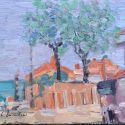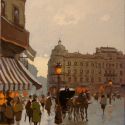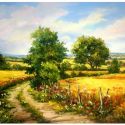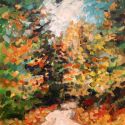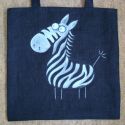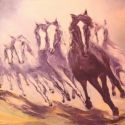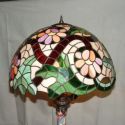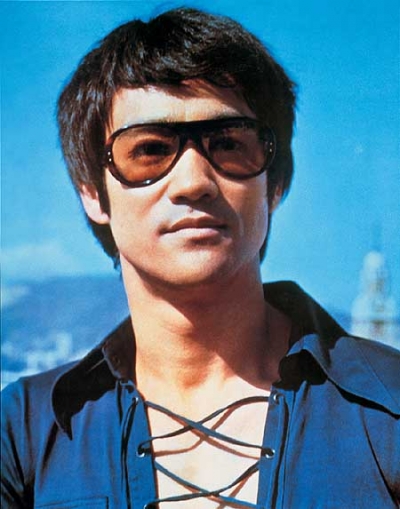
Foto: 1
Biography
Early life
Bruce Lee was an American Born Chinese (ABC) born at the Chinese Hospital[2] in San Francisco to his Chinese father, Lee Hoi-Chuen and Chinese-German[3] mother Grace Lee.
Names
Lee's Cantonese name, Lee Jun Fan ( Mandarin Pinyin: Lǐ Zhènfán), literally means "invigorate San Francisco "[4]. At birth, Bruce Lee was given the English name "Bruce" by Dr. Mary Glover. Mrs. Lee had not initially planned on an American name but deemed it appropriate and concurred with Dr. Glover[5]. Interestingly the name "Bruce" was never used within his family until he enrolled in La Salle College, a Hong Kong high school, at 12 years of age[4].
In addition, Lee initially had a birth name (Li Yuen Kam)[2]( Mandarin Pinyin: Lǐ Xuànjīn) given by his mother, as at the time Lee's father was away on a Chinese opera tour. After several months, when Lee's father returned, the name was abandoned because of a conflict with the name of Lee's grandfather. Lee was then renamed Jun Fan. Finally, Lee was also given a feminine name, Sai Fung (, literally "small Phœnix"), used throughout his early childhood in keeping with a Chinese custom traditionally thought to hide the child from evil spirits.
Screenshot from Thunderstorm, one of a few movies Lee Siu Lung starred in as a teenager.
Bruce Lee's screen name was Lee Siu Lung in Cantonese and Li Xiao Long in Mandarin (Cantonese pengyam: Ley5 Siw2 Long4; Mandarin Pinyin: Lǐ Xiǎolóng) which literally means "Lee Little Dragon." These were first used by director of the 1950 Cantonese movie in which Lee performed. It was very likely that the name "little dragon" was chosen based on his childhood name "small phoenix". In Chinese tradition, dragon and phoenix come in pairs to represent the male and female genders, respectively.
Education and martial arts training
Bruce Lee was educated both academically and in the field of martial arts. His studies of Kung Fu sparked his enthusiasm and understanding of martial arts in the development of Jeet Kune Do. Later Lee studied Judo, Jujitsu, Western Boxing, and other styles of martial arts.
Lee received his early education and Kung Fu training in Hong Kong. Because of his father's fame as a Chinese opera actor, Lee had the opportunity to appear in several Hong Kong movies as a child. He studied the Wing Chun style of martial arts at a young age and learned English, Cantonese, and Mandarin.
Having seen his father practice Tai Chi Chuan, Lee was enrolled in Wing Chun under Sifu Yip Man. Wing Chun would later form a base for his later development and evolution of martial arts and the development of Jeet Kune Do.
At age 14, Bruce Lee entered La Salle College, a high school, under the wing of Brother Henry. In 1959, Bruce got into a fight with a feared Triad gang member's son, and his father worried, so he and his wife decided to send Bruce to the United States to live with an old friend of his father's. All he had was $100 in his pocket and the title of 1958 Crown Colony Cha Cha Champion of Hong Kong. After living in San Francisco, he moved to Seattle to work for Ruby Chow, another friend of his father's.
In 1959, Lee completed his high school education in Seattle and received his diploma from Edison Technical School. He enrolled at the University of Washington as a philosophy major. It was at the University of Washington that he met his future wife, Linda Emery, whom he would marry in 1964. Lee had two children: a daughter, Shannon, and a son, actor Brandon Lee, who was tragically killed in a film set accident in 1993.
Early acting career
A few credits short of graduation from the University of Washington as a philosophy major, Lee headed to San Francisco and then Hollywood.
In 1964 at a demonstration in Long Beach, California, the soon-to-be-famous Lee met Karate champion Chuck Norris. Lee would later introduce Norris to portray one of Lee's opponents in Return of the Dragon, aka Way of the Dragon, in a famous Colosseum fight scene.
Lee went on to star as Kato in the TV series The Green Hornet, which ran from 1966 to 1967 and afterward opened up his own Jeet Kune Do school. Later Lee would use filmmaking to demonstrate his fighting theories.
Success in Hong Kong
In 1971, unable to find acting roles and faced with stereotypes regarding Asian actors, Lee returned to Hong Kong with his family. There, he starred in martial arts movies, earning $30,000 for his first two feature films, cementing his fame.
Physical training, fitness, and nutrition
Lee flexing (1972), front
Bruce Lee cared deeply about his physical fitness and he became famous for his physical condition despite his small stature. Lee typically exhibited a muscular and very lean appearance in his films, particularly in his upper body. Bruce Lee felt many martial artists of his day lacked the necessary physical fitness to back up their fighting skills.
Bruce Lee used many different techniques and resources in aiding his physical fitness, including the use of electric current as an aid to strength training. However, this muscle stimulator was only one of many pieces of equipment and exercise routines Lee used to achieve his fighting ability. Footage of Lee performing a fighting scene, was often slowed down because it would only show as a blur on screen. Lee developed a trick for showing off his speed: a person held a coin and closed his hand, and as he closed it, Lee would take it and could even swap the coin for another.
The weight training program Lee used during a stay in Hong Kong in 1965, indicated bicep curls of 80 pounds and 8 repetitions[3] for endurance. This translates to an estimated one repetition maximum of 110 pounds[4], placing Lee in approximately the 100th percentile for the 121 to 140 pound weight class[5].
Bruce Lee was light because he was more interested in lean muscles and not bulky mass. His exercise routines consisted of a lot of things, for example weights and cardiovascular training. Bruce did not resort to traditional "body building" techniques to build mass, he was more interested in speed and power. He developed strategies to increase muscle strength and speed.
Lee believed the abdominal muscles were one of the most important muscle groups for a martial artist since virtually every movement requires some degree of abdominal work. Perhaps more importantly, the "abs" are like a shell, protecting your ribs and vital organs.
Bruce Lee's washboard abs did not come from mere abdominal training; he was also a proponent of cardiovascular conditioning and would regularly run, jump rope and ride a stationary bicycle. A typical exercise for Lee would be to run a distance of two to six miles in 15 to 45 minutes.
Nutrition
Another element in Bruce Lee's quest for abdominal definition was nutrition. According to Linda Lee, soon after he moved to the United States, Bruce started to take nutrition seriously and developed an interest in health foods and high-protein drinks. He ate lean meat sparingly and consumed large amounts of fruits and vegetables. In later years, he studied vitamin supplements.
1964 Long Beach International Karate Championships
"one inch punch"
At the invitation of Ed Parker, Lee appeared in the 1964 Long Beach International Karate Championship and performed repetitions of two-finger pushups (using the thumb and the index finger) with feet at approximately a shoulder-width apart. In the same Long Beach event he also performed the "one inch punch," the description of which is as follows: Lee stood upright, his right foot forward with knees bent slightly, in front of a standing, stationary partner.
two finger push up
Lee's right arm was partly extended and his right fist approximately an inch away from the partner's chest. Without retracting his right arm, Lee then forcibly delivered the punch to his partner while largely maintaining his posture, sending the partner backwards and falling into a chair placed behind the partner to prevent injury.
Bruce Lee's feats
Here are some of Bruce Lee's real life feats of speed, strength and endurance. This information is taken from various documentaries and magazines.
Bruce Lee's striking speed from 2 feet away was five hundredths of a second. (Glover[6])
Bruce did push ups using only 2 fingers.
Bruce was able to break a 150lb bag with a sidekick. (Coburn[7])
Bruce would ride for 45 minutes (10 Miles) on a stationary bike, sweating profusely afterwards. (Uhera [8])
Bruce's last movie Enter the Dragon was made for $850,000 in 1973 ($3.75 million in 2005 currency[9]). To date, Enter the Dragon has grossed over $90,000,000. (IMDB.com[10])
Quotes from Bruce Lee's friends
These are some quotes from Bruce Lee's friends about his feats of strength: [11]
Chuck Norris
"Lee, pound for pound, might well have been one of the strongest men in the world, and certainly one of the quickest."
Doug Palmer
"Bruce was like the Michael Jordan or Muhammad Ali in his prime, somebody who stood above everyone else. It's not that the other martial artists weren't good. It's just that this guy was great."
Herb Jackson
"The biggest problem in designing equipment for Bruce was that he'd go through it so damn fast. I had to reinforce his wooden dummy with automobile parts so he could train on it without breaking it. I had started to build him a mobile dummy that could actually attack and retreat to better simulate "Live" combat, sadly Bruce died before the machine was built. It would have been strung up by big high-tension cables that I was going to connect between two posts, one on either side of his backyard. The reason for the machine was simply because no one could stand up to his full force punches and kicks, Bruce's strength and skill had evolved to point where he had to fight machines."
"He never trained in a gym, he thought he could concentrate better at home, so he worked out on his patio. He had a small weight set, something like a standard 100lb cast-iron set. In addition, he had a 310lb Olympic barbell set, a bench press and some dumbbells, both solid and adjustable."
"Bruce used to beat all other comers at this type of wrist wrestling and even joked that he wanted to be world champion at it."
James Coburn
"Bruce and I were training out on my patio one day, we were using this giant bag for side kicks, I guess it weighed about 150lbs. Bruce looked at it and just went Bang, it shot up out into the lawn about 15ft in the air, it then busted in the middle. It was filled with little bits and pieces of rag, we were picking up bits of rag for months."
Jesse Glover
"When he could do push ups on his thumbs and push ups with 250lbs on his back, he moved on to other exercises."
"The power that Lee was capable of instantly generating was absolutely frightening to his fellow martial artists, especially his sparring partners, and his speed was equally intimidating. We timed him with an electric timer once, and Bruce's quickest movements were around five hundredths of a second, his slowest were around eight hundredths. This was punching from a relaxed position with his hands down at his sides from a distance between 18-24 inches. Not only was he amazingly quick, but he could read you too. He could pick up on small subtle things that you were getting ready to do and then he'd just shut you down."
"Bruce was gravitating more and more toward weight training as he would use the weighted wall pulleys and do series upon series with them. He'd also grab one of the old rusty barbells that littered the floor at the YMCA and would roll it up and down his forearms, which is no small feat when you consider that the barbell weighed 70lbs."
Jim Kelly
"Bruce, well I can basically say this. I have been around a lot of great martial arts fighters. Worked out with them. Fought them in tournaments. In my opinion Bruce Lee was the greatest martial artist who ever lived. To me thats my opionion. I think Bruce lee is the greatest martial artist ever. I don't think anybody is in his class."
Joe Lewis
"Bruce was incredibly strong for his size. He could take a 75lb barbell and from a standing position with the barbell held flush against his chest, he could slowly stick his arms out, lock them and hold the barbell there for 20 seconds, that's pretty damn tough for a guy who at the time only weighed 138lbs. I know 200lb weight lifters who can't do that."
" I never stood in front of another human who was as quick as him. He not only had the quickness but he had the inner confidence to muster the conviction to do so. I've seen others who had the speed but lack conviction or vice versa. He was like Ali, he had both.I stood before both of these men, so I know."
"If Bruce Lee wasn´t the greatest martial artist of all time, then certainly he is the number one candidate." (Source)
Leo Fong
"Yes, I was on the receiving end of his side kick. It was like getting hit with a truck."
Mito Uhera
"Bruce always felt that if your stomach wasn't developed, then you had no business doing any hard sparring."
Death, "by misadventure"
Bruce Lee's death was officially attributed to cerebral edema.
On July 20, 1973, Lee was in Hong Kong, due to have dinner with former James Bond star George Lazenby, with whom he intended to make a film. According to Lee's wife, Linda, Bruce met producer Raymond Chow at two p.m. at home to discuss the making of the movie Game of Death. They worked until four p.m., and then drove together to the home of Betty Ting Pei, a Taiwanese actress and Bruce Lee's alleged mistress, who was to have a leading role in the film. The three went over the script at her home, and then Chow left to attend a dinner meeting.
A short time later, Lee complained of a headache, and Ting Pei gave him an analgesic. At around 7:30 p.m., he lay down for a nap. After Lee didn't turn up for the dinner, Chow came to the apartment but could not wake Lee up. A doctor was summoned, who spent ten minutes attempting to revive him before sending him by ambulance to Queen Elizabeth Hospital. However, Lee was dead by the time he reached the hospital. There was no visible external injury; however, his brain had swollen considerably, from 1,400 to 1,575 grams (113%). Lee was thirty two years old. On October 15, 2005, Chow stated in an interview that Lee was allergic to Equagesic, an analgesic formulation containing meprobamate, aspirin and ethoheptazine. When the doctors announced Bruce Lee's death officially, it was coined as "Death by Misadventure".
However, the exact details of Lee's death are controversial. Bruce Lee's iconic status and unusual death at a young age led many people to develop many theories about Lee's death, such as a murder involving an ancestral curse, triads, gangsters, sudden death in epilepsy and so on — none of these have ever been proven. At the 2006 meeting of the American Academy of Forensic Sciences, Dr James Filkins, formerly of the Cook County medical examiner's office in Chicago suggested that Lee had died from Sudden Unexpected Death In Epilepsy (SUDEP), a syndrome only recognised in 1995 [12].
Martial arts lineage
Lineage in Wing Chun / Jeet Kune Do
Sifu in Wing Chun
Yip Man
Other instructors
Sihing Wong Shun-leung
Learned Filipino stick fighting skill (Eskrima) from Dan Inosanto
Learned Tang Soo Do high kicking skill from Chuck Norris
Learned Judo fighting skills from Gene Lebell
Sifu Gin Foon Mark (Praying mantis kung fu)
Bruce Lee
Creator of Jeet Kune Do
Known students in Wing Chun
Unknown
Known students in Jeet Kune Do
Taky Kimura
Dan Inosanto
Allen Joe
Ted Wong
Jesse Glover
Charlie Woo
James W. DeMile
Joe Lewis
Larry Hartsell
Numerous others...
Famous students who learned
Jeet Kune Do from Bruce Lee
Chuck Norris
Kareem Abdul-Jabbar
James Coburn
Roman Polanski
Lee Marvin
Steve McQueen
Numerous others...
Filmography
Lee starred in a leading role in a total of five major films, two of which (Enter the Dragon, Game of Death) premiered after his death.
1 The Big Boss
Fists of Fury
Plays "Cheng Chao-an". Fights against a drug lord (The Big Boss) in Thailand.
2 Fist of Fury
The Chinese Connection
Plays the character "Chen Zhen" Fights against Japanese tyrants in Shanghai.
3 Way of the Dragon
Return of the Dragon
Plays "Tang Lung". Fights crime in Rome, Italy. Released after Enter the Dragon in the U.S. hence the title.
4 Enter the Dragon
same
Plays Shaolin Monk "Mr. Lee". Fights an ex-monk turned drug lord in Hong Kong to avenge his sister.
5 Game of Death
Plays Martial arts master "Billy Lo". Pieced together with few fight scenes after his death.[13]
Note: The English titles for the first two films were swapped by the U.S. distributor. The title The Chinese Connection (a play on the then-recently-released The French Connection) was originally intended for The Big Boss due to the drugs theme of the story.
Yuen Lo (Later to become action super star Jackie Chan), was a member of the Seven Little Fortunes he was a stunt double for the villain Mr Suzuki in Bruce's Fist of Fury at the time it was a record as he fell 15 feet without the aid of safety equipment. Also, during filming of Enter the Dragon Jackie was hit in the face by Bruce's feared nunchucks
Yuen Wah, also a member of the Seven Little Fortunes, and later to become a well known actor in his own right (notably starring in 2005's Kung Fu Hustle), was Lee's stunt double in Lee's last few films.
David Carradine played the characters written for Lee in the 1978 version of The Silent Flute.
List of people influential to Bruce Lee's Martial Arts
Yip Man
Wong Shun-leung
William Cheung
Steve McQueen
Gene LeBell
Jesse Glover
Ed Parker
Dan Inosanto
Chuck Norris
Kareem Abdul-Jabbar
Muhammad Ali
James Coburn
Wally Jay
Stirling Silliphant
Charles B. Fitzsimons
Jhoon Rhee
Alan Watts
Wong Jack Man
Raymond Chow of Golden Harvest
G.J. Torres
James Yimm Lee
Philosophy
Although Bruce Lee is best known as a martial artist and actor, Lee majored in philosophy at the University of Washington. Lee's books on martial arts and fighting philosophy are well-known both for their philosophical assertions both inside and outside of martial arts circles. His philosophy often mirrored his fighting beliefs, though he was quick to claim that his martial arts were solely a metaphor for such teachings. His influences include Taoism and Buddhism.
The following are some of Bruce Lee's quotes on that reflect his fighting philosophy, primarily derived from Jiddu Krishnamurti's teachings.[14]
"If I tell you I'm good, you would probably think I'm boasting, If I tell you I'm no good, You KNOW I'm lying."
"Be formless... shapeless like water. If you put water into a cup it becomes the cup. You put water into a bottle it becomes the bottle. You put it into a teapot it becomes the teapot. Water can flow, and it can crash. Be water, my friend..."
"Use only that which works, and take it from any place you can find it."
"The more relaxed the muscles are, the more energy can flow through the body. Using muscular tensions to try to "do" the punch, or attempting to use brute force to knock someone over, will only work to opposite effect."
"Mere technical knowledge is only the beginning of Kung Fu, to master it, one must enter into the spirit of it."
"There are lots of guys around the world that are lazy. They have big fat guts. They talk about chi power and things they can do, but don't believe it."
"I'm not a master, I'm a student-master, meaning that I have the knowledge of a master and the expertise of a master, but I'm still learning, So I'm a student-master. I don't believe in the word master, I consider the master as such when they close the casket."
"Do not deny the classical approach, simply as a reaction, or you will have created another pattern and trapped yourself there."
"Jeet Kune Do, It's just a name, don't fuss over it. There's no such thing as a style if you understand the roots of combat."
"Unfortunately, now in boxing people are only allowed to punch. In Judo, people are only allowed to throw. I do not despise these kinds of martial arts. What I mean is, we now find rigid forms which create differences among clans, and the world of martial art is shattered as a result."
"I think the high state of martial art, in application, must have no absolute form. And, to tackle pattern A with pattern B may not be absolutely correct."
"True observation begins when one is devoid of set patterns."
"The other weakness is, when clans are formed, the people of a clan will hold their kind of martial art as the only truth, and do not dare to reform or improve it. Thus they are confined in their own tiny little world. Their students become machines which imitate martial art forms."
"Some people are tall, some are short. some are stout, some are slim. There are various different kinds of people. If all of them learn the same martial art form, then who does it fit?"
"Ultimately, martial art means honestly expressing yourself. It is easy for me to put on a show, and be cocky so I can show you some really fancy movement. But to express oneself honestly, not lying to oneself, and to express myself honestly enough; that my friend is very hard to do."
"Use no way as way, use no limitation as limitation."
See Wikiquotes for more quotes by Bruce Lee.
Books Authored
Chinese Gung-Fu: The Philosophical Art of Self Defense
Books about Bruce Lee and/or JKD
Jeet Kune Do: Principles of a Complete Fighter
Jeet Kune Do: Hardcore Training Methods
Absorb What Is Useful - Written by Dan Inosanto mostly about JKD training practices.
The Tao of Bruce Lee - Written by Davis Miller mostly about Bruce Lee.
Striking Thoughts - Thoughts and quotes of Bruce Lee
Awards and honors
With his ancestral roots coming from Gwan'on in Seundak, Guangdong province of China ( Guangdong Shunde Jun'An), a street in the village is named after him where his ancestral home is situated. The home is open for public access.
Bruce Lee was named TIME Magazine's 100 Most Important People of the Century and as one of the greatest heroes & icons and among the influential martial artists of the 20th century.
The 1993 film Dragon: The Bruce Lee Story is a slightly fictionalized biographical film about Bruce Lee.
In 2001, LMF, a Cantonese hip-hop group in Hong Kong, released a popular song called "1127" as a tribute to Bruce Lee. The lyrics include: "We only want you to become a Chinese you can be proud of. Learn from others; Need not copy. Use your heart to digest the knowledge of others. Try asking why there are so many failures here who do not support each other and always pretend to be like the other. [Chorus] We had Bruce Lee teach us we are not the disease of Asia. Though having yellow skin, we can still be ourselves. Do not follow, copy, and be like the other. Do not look down upon ourselves.... The spirit of Bruce Lee will never die and the Chinese will never forget that."
In 2004, UFC president Dana White credits Bruce Lee as the "father of mixed martial arts"[15].
In September 2004, a a BBC story stated that the Herzegovinian city of Mostar was to honour Lee with a statue on the Spanish Square, as a symbol of solidarity. After many years of war and religious splits, Lee's figure is to commend his work: to successfully bridge culture gaps in the world. The statue, placed in the city park, was unveiled on November 26, 2005 (One day before the unveiling of the statue in Hong Kong, below).
In 2005, Lee was remembered in Hong Kong with a bronze statue to mark his 65th birthday. The bronze statue, unveiled on November 27, 2005 honoured Lee as "Chinese film's bright star of the century". [16]
Lee and popular culture
Main article: Bruce Lee and popular culture
There exists numerous references to Lee in popular culture, which are covered in a separate article.
Bruce Lee Documentaries
Bruce Lee: the man the legend
Dragon: The Bruce Lee Story
Dragon Warrior
The Life and Legend of Bruce Lee (1973) with Steve McQueen
[17]
CG resurrection
Using computer graphics technology, a South Korean filmmaker Chul Shin is making a $50 million movie called Dragon Warrior that will be the first to feature a long-dead Bruce Lee in a leading role[18]. Film company ShinCine have the approval of Linda Lee Cadwell and Shannon Lee [19].
Further reading
Bleeker, Tom Unsettled Matters: The Life & Death of Bruce Lee Gilderoy Pubns. July, 1996. ISBN 0965313204
Lee, Linda; Lee, Mike; and Vaughn, Jack. The Bruce Lee Story Ohara Publications. June, 1989. ISBN 0897501217
Little, John R. The Warrior Within: The Philosophies of Bruce Lee. McGraw-Hill. April 1, 1996. ISBN 0809231948
See also
Bruce Lee and popular culture
Dragon Warrior
Enter the Dragon
Fist of Fury
Game of Death
Jeet Kune Do
Spike Spiegel
The Big Boss
Way of the Dragon
Wing Chun
Footnotes
↑ "Bruce Lee King of Kung-Fu", Dennis, Felix & Atyeo, Don, Straight Arrow Books, U.S. (1974) First Printing, ISBN 0-87932-088-5
↑ Chinese Hospital [1] - Radiology 845 Jackson Street, San Francisco, CA 94133.
↑ Yang, Jeff, et all. Eastern Standard Time: A Guide to Asian Influence on American Culture. Boston/New York: Meridian/Houghton Mifflin, 1997.
↑ a b "The Bruce Lee Story", Lee, Linda & Bleecker, Tom, OHRA PUBLICATIONS INC., U.S. (1989) First Printing, ISBN 0-89750-121-7
↑ "Bruce Lee The Untold Story", Lee, Grace & Unique Pub. Editors, CFW Enterprise UNIQUE PUBLICATIONS, U.S. (1980) First Printing, ISBN 0865680094
Old references
^ Lee, Linda. 1989. The Bruce Lee Story Ohara Publications, California. (p.70)
^ Hatfield, Fredrick C., Ph. D. 1993. Fitness: The Complete Guide. International Sport Sciences Association, California. (p.119)
^ Wathen, Dan. 1994. Load Assignment. In Essentials of Strength Training and Conditioning. Human Kinetics, Illinois. (p.436)
^ MobyGames [20]
^ Dorgan, Michael. Bruce Lee's Toughest Fight [21]. (1980 July). Official Karate. (The neutrality of this article is debatable).
^ Pieced together with the few shots that were filmed before Lee's death in 1973.
^ Wickert, Marc. 2004. Dana White and the future of UFC. kucklepit.com. See Wikiquotes for the text.
^ Miscellaneous. bruceleedivinewind.com page The accuracy of this source has been disputed: see here.
^ Internet Movie Database. [22]



